溶血尿毒综合征
- 格式:ppt
- 大小:9.72 MB
- 文档页数:51

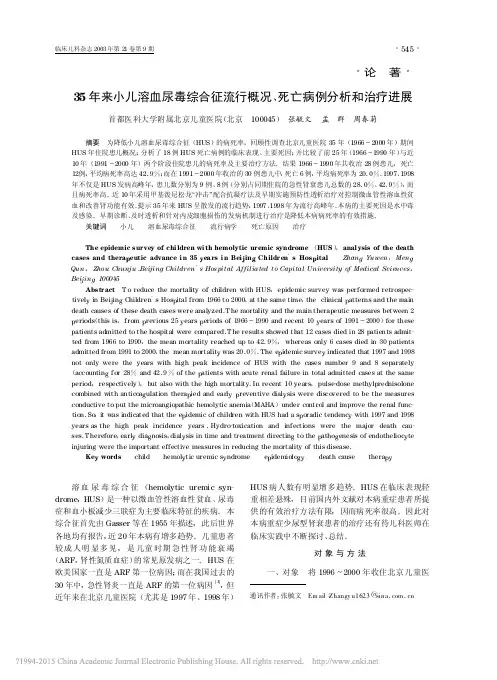
35年来小儿溶血尿毒综合征流行概况、死亡病例分析和治疗进展首都医科大学附属北京儿童医院(北京100045)张毓文孟群周春菊·论著·摘要为降低小儿溶血尿毒综合征(HUS)的病死率,回顾性调查北京儿童医院35年(1966~2000年)期间HUS年住院患儿概况;分析了18例HUS死亡病例的临床表现、主要死因;并比较了前25年(1966~1990年)与近10年(1991~2000年)两个阶段住院患儿的病死率及主要治疗方法。
结果1966~1990年共收治28例患儿,死亡12例,平均病死率高达42.9%;而在1991~2000年收治的30例患儿中,死亡6例,平均病死率为20.0%。
1997、1998年不仅是HUS发病高峰年,患儿数分别为9例、8例(分别占同期住院的急性肾衰患儿总数的28.0%、42.9%),而且病死率高。
近10年采用甲基泼尼松龙“冲击”配合抗凝疗法及早期实施预防性透析治疗对控制微血管性溶血性贫血和改善肾功能有效。
提示35年来HUS呈散发的流行趋势,1997、1998年为流行高峰年。
本病的主要死因是水中毒及感染。
早期诊断、及时透析和针对内皮细胞损伤的发病机制进行治疗是降低本病病死率的有效措施。
关键词小儿溶血尿毒综合征流行病学死亡原因治疗The epidemic survey of children with hemolytic uremic syndrome(HUS),analysis of the death cases and thera p eutic advance in35y ears in Bei j in g Children's Hos p ital Zhan g Yuwen,Men g Qun,Zhou Chunju.Beijing Children's Hospital Affiliated to Capital University of Medical Sciences, Bei j in g100045Abstract T o reduce the mortality of children with HUS,epidemic survey was performed retrospec-tivel y in Bei j in g Children's Hos p ital from1966to2000,at the same time,the clinical p atterns and the main death causes of these death cases were analyzed.T he mortality and the main therapeutic measures between2 p eriods(this is,from p revious25y ears p eriods of1966~1990and recent10y ears of1991~2000)for these patients admitted to the hospital were compared.T he results showed that12cases died in28patients admit-ted from1966to1990,the mean mortality reached up to42.9%,whereas only6cases died in30patients admitted from1991to2000,the mean mortalit y was20.0%.The e p idemic surve y indicated that1997and1998 not only were the years with high peak incidence of HUS with the cases number9and8separately (accountin g for28%and42.9%of the p atients with acute renal failure in total admitted cases at the same period,respectively),but also with the high mortality.In recent10years,pulse_dose methylprednisolone combined with anticoa g ulation thera p ied and earl y p reventive dial y sis were discovered to be the measures conductive to put the microangiopathic hemolytic anemia(MAHA)under control and improve the renal func-tion.So,it was indicated that the e p idemic of children with HUS had a s p oradic tendenc y with1997and1998 years as the high peak incidence years.Hydro_toxication and infections were the major death cau_ ses.T herefore,earl y dia g nosis,dial y sis in time and treatment directin g to the p atho g enesis of endothelioc y te injuring were the important effective measures in reducing the mortality of this disease.Ke y words child hemol y tic uremic s y ndrome e p idemiolo gy death cause thera py溶血尿毒综合征(hemol y tic uremic s y n-drome,HUS)是一种以微血管性溶血性贫血、尿毒症和血小板减少三联症为主要临床特征的疾病。
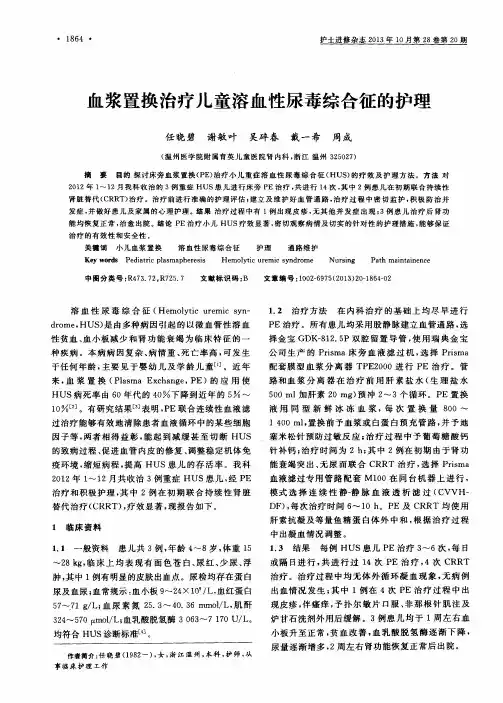
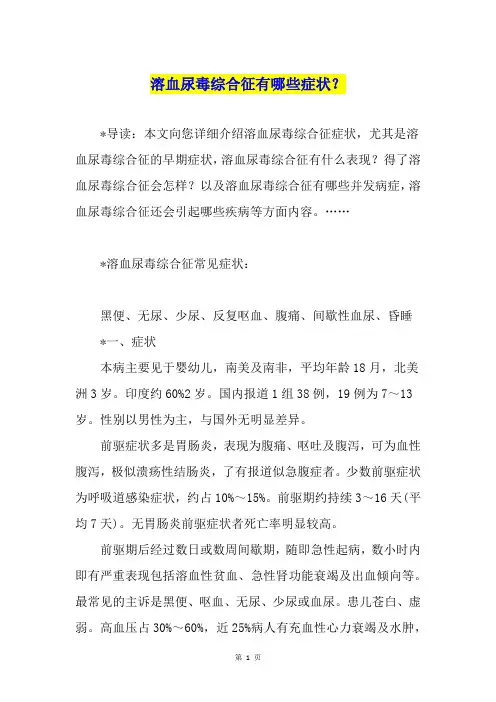
溶血尿毒综合征有哪些症状?*导读:本文向您详细介绍溶血尿毒综合征症状,尤其是溶血尿毒综合征的早期症状,溶血尿毒综合征有什么表现?得了溶血尿毒综合征会怎样?以及溶血尿毒综合征有哪些并发病症,溶血尿毒综合征还会引起哪些疾病等方面内容。
……*溶血尿毒综合征常见症状:黑便、无尿、少尿、反复呕血、腹痛、间歇性血尿、昏睡*一、症状本病主要见于婴幼儿,南美及南非,平均年龄18月,北美洲3岁。
印度约60%2岁。
国内报道1组38例,19例为7~13岁。
性别以男性为主,与国外无明显差异。
前驱症状多是胃肠炎,表现为腹痛、呕吐及腹泻,可为血性腹泻,极似溃疡性结肠炎,了有报道似急腹症者。
少数前驱症状为呼吸道感染症状,约占10%~15%。
前驱期约持续3~16天(平均7天)。
无胃肠炎前驱症状者死亡率明显较高。
前驱期后经过数日或数周间歇期,随即急性起病,数小时内即有严重表现包括溶血性贫血、急性肾功能衰竭及出血倾向等。
最常见的主诉是黑便、呕血、无尿、少尿或血尿。
患儿苍白、虚弱。
高血压占30%~60%,近25%病人有充血性心力衰竭及水肿,30%~50%病人肝脾肿大,约1/3病人有皮肤瘀斑及皮下血肿,15%~30%小儿有黄疸。
有些症状因地区而异,如在印度本病常合并于痢疾后起闰。
60%有发热。
在阿根廷及澳大利亚则中枢神经系统症状较常见占28%~52%,表现为嗜睡、性格异常、抽搐、昏迷、偏瘫、共济失调等。
根据先驱症状及突然出现的溶血性贫血、血小板减少及急性肾功能衰竭三大特征不难作出诊断,但应与其他原因引起的急性肾功能衰竭、肾小球肾炎、血小板减少及溶血性贫血等鉴别。
主要决定预后的是肾脏损害的程度。
86%~100%有少尿,30%病人无尿(持续4天~数周)。
某些婴儿病例仅有一过性少尿及尿异常。
大多数病人肾功能可完全恢复。
有的发生慢性肾功能不全及高血压。
本病患儿可有复发,复发者预后差。
*以上是对于溶血尿毒综合征的症状方面内容的相关叙述,下面再看下溶血尿毒综合征并发症,溶血尿毒综合征还会引起哪些疾病呢?*溶血尿毒综合征常见并发症:急性肾功能衰竭、充血性心力衰竭、肺水肿、高血压脑病、高钾血症、代谢性酸中毒、智力低下、癫痫*一、并发病症急期可出现各种急性肾功能衰竭的并发症如充血性心力衰竭、肺水肿、高血压脑病、高钾血症、代谢性酸中毒等。
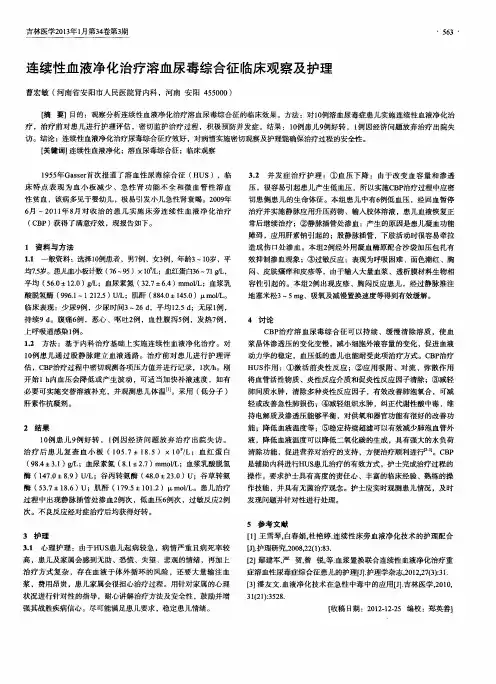
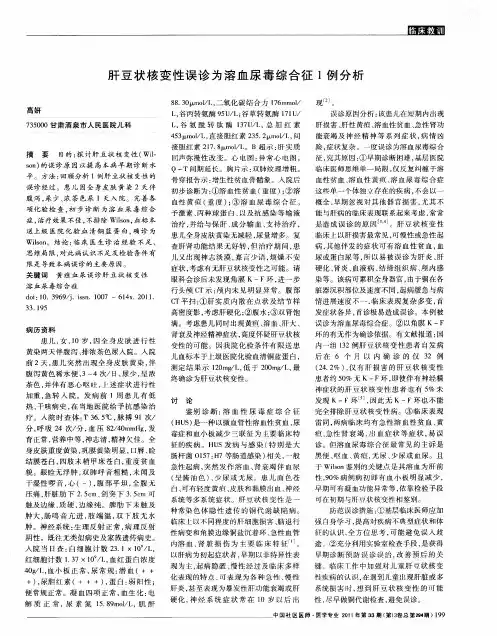
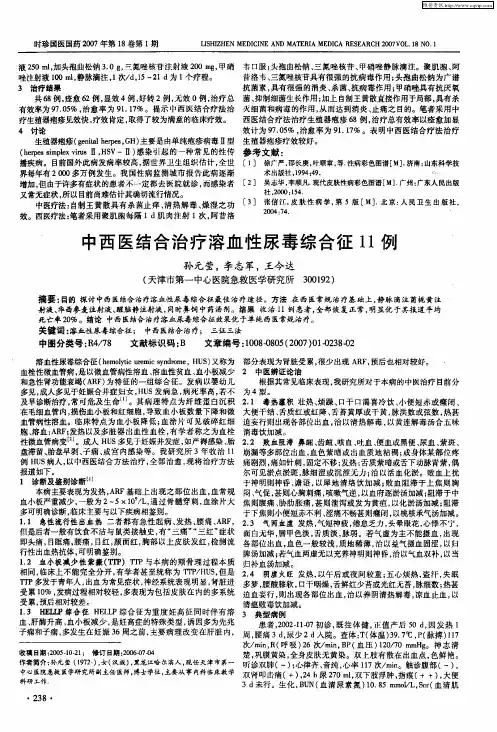
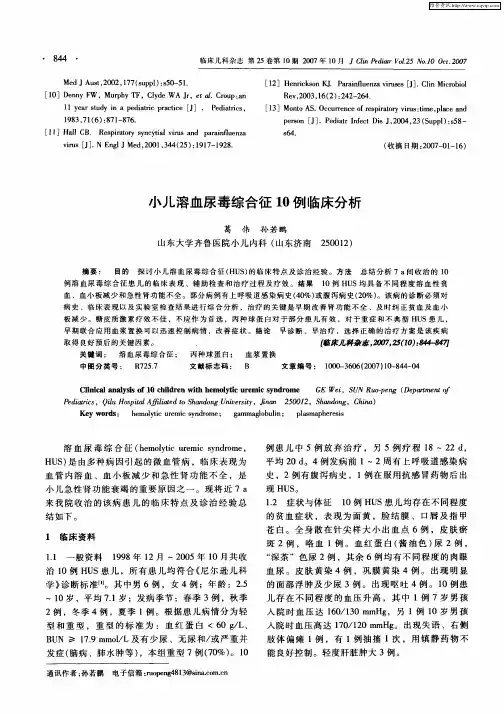
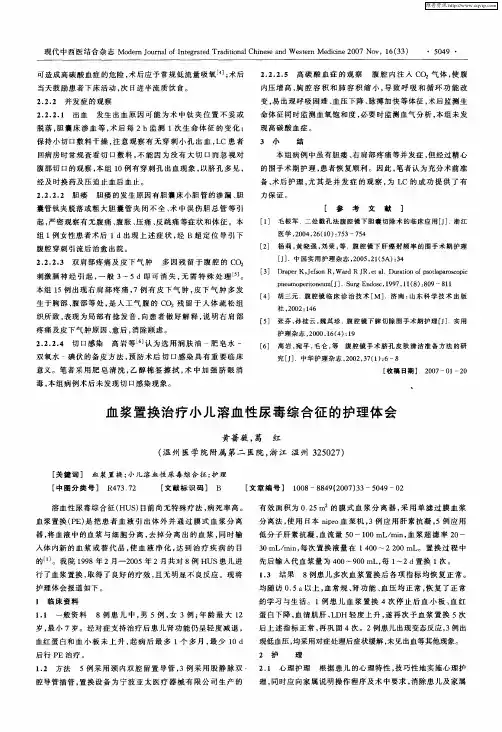
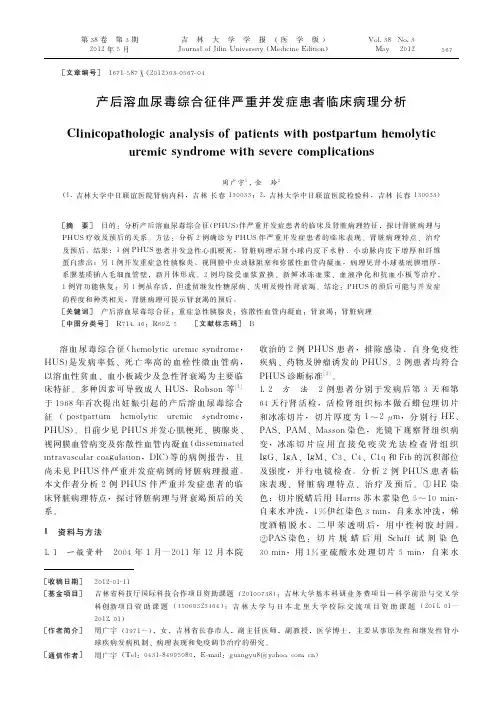
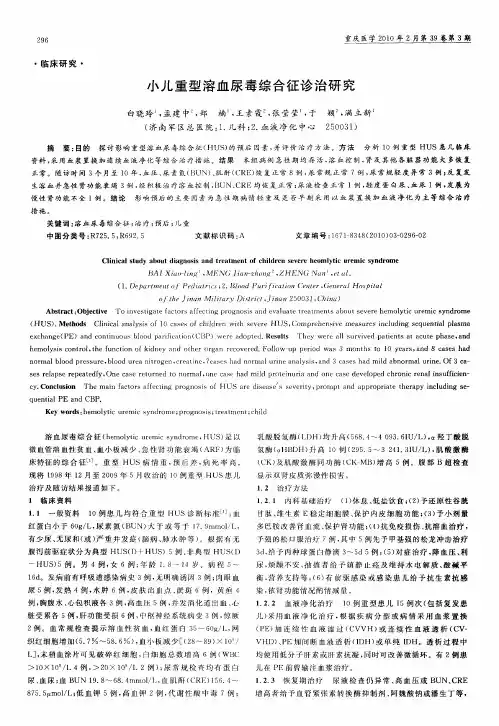
血浆置换联合连续血液滤过救治小儿溶血尿毒综合征的机制探讨荣鹏,孟建中,白晓玲,王素霞,刘文渊,于颖,高飞(济南军区总院,济南250011)摘要:血浆置换(PE)联合连续血液净化(CB P)对小儿溶血尿毒综合征(HUS)的疗效观察及机制探讨。
回顾性分析21例重型HUS患儿在内科综合治疗同时,采用序贯血浆置换(PE)加连续性静-静脉血液滤过(C V VH)治疗前后生命体征、炎性细胞因子、生化指标等的变化。
经序贯PE加CBP治疗后患儿全身状况迅速改善,溶血控制,尿量增加,肾及其他各脏器功能检测指标逐步恢复正常,治疗前后炎性细胞因子、生化指标等具有显著差异。
说明PE联合CBP救治重型溶血尿毒综合征能显著清除致病性细胞因子,稳定内环境,改善内皮细胞功能增强疗效,尽早治疗可缩短病程,改善预后。
关键词:血浆置换;连续血液净化;溶血尿毒综合征;小儿;内皮细胞中图分类号:R318文献标识码:A文章编号:1672-6278(2011)01-0046-03Mechanism of Sequential Plasma Exchange and Continuous Blood Purification in the Treatment o f Children Hemolytic Uremic SyndromeRONG Peng,MENG Jianzhong,BAI Xiaoling,WANG Suxia,LIU Wenyuan,YU Ying,GAO Fei(Jinan M ilitary A rea G eneral Ho spital o f PL A,Jinan250011,China)Abstr act:To discuss the mechanism of sequential plasma exchange(PE)and continuo us blo od purification(CBP)in the treatment of children hemoly tic uremic sy nd rome(HU S)as well as the therapeutic effectiveness.The change in vital sign,so me cytokine and biochemical indicato r befo re and after PE+CBP treatment in21cases of HUS w ith conventional treatment were analyzed.A fter PE+CBP,rapid i mprovement occurred in sy stematic co nditions,hemolytic co ntrol,urine increase.Functio ns o f kidney and other o rgans g radually reco vered to normal,they w ere all survived patients at acute phase and hemoly tic control,the function of kidney and o ther o rgan recovered.There w ere sig nifican tly differences in some cytokine and biochemical indicator before and after PE and CBP treatment.PE+CBP treat hemoly tic uremic sy ndro me can significantly remove so me of the pathogenic cy to kines,stablize internal environ ment,impro ve endothelial cell function to enhance efficacy,early treatmen t can shorten the course o f the di sease and improve prog nosi s.Key wor ds:Plasma exchange;Continuous blo od p uri ficatio n;Hemoly tic uremic syndro me;Paediatrics;Vascular endo thelial cells1引言溶血尿毒综合征(hemo ly tic uremic sy ndro me, HUS)是以急性微血管病性溶血性贫血、血小板减少和急性肾功能不全为主要特征的临床综合征。